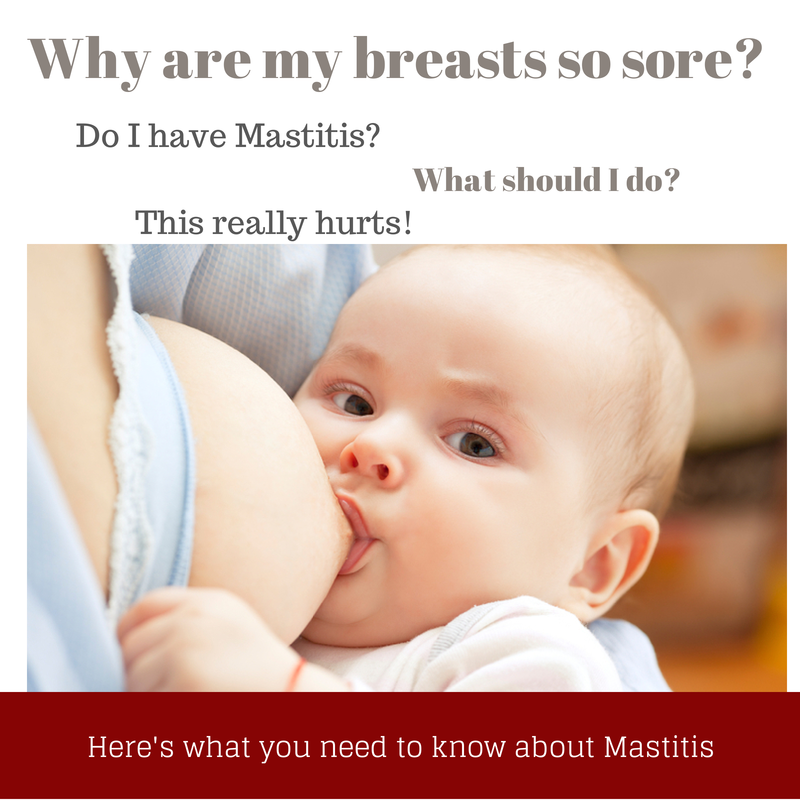Why are my breasts red and sore? How do I know if I have Mastitis?
Posted by Katie James, Midwife and Lactation Consultant on May 08, 2014
Mastitis means Inflammation of the breast. It may or may not be associated with a bacterial infection. Early Mastitis may be inflammation of the breast whereas prolonged or severe mastitis is likely caused by an infection.
In Australia, mastitis affects about 20% of women, with most episodes occurring in the first 6 weeks after birth. This is likely due to mothers still learning the art of good breastfeeding, coupled with tiredness and stress.
In this blog post we'll cover:
Likely reasons for developing Mastitis:
- Poor milk drainage due to:
- Poor positioning and attachment whilst breastfeeding
- Missed feeds or long intervals between feeds – leading to a build-up of milk and inflammation around the milk ducts.
- Tongue-tie (possibly) – baby is unable to drain the breast fully or may damage the nipple.
- Restrictive clothing/external pressure on the breast – leading to milk ducts not being able to be fully drained and causing blockages and inflammation.
- Trauma/damage to the breasts or nipples from poor attachment
- Engorgement and/or chronic oversupply
- Unresolved blocked ducts
- Rapid or abrupt weaning
- Stress
- Extreme fatigue
- Overall poor health and nutrition
- Previous history of mastitis
- Area of redness in breast
- Tender area in the breast
- Lump or hard area
- Area of redness feels hot
- Fever >38c
- May have a fever
- Pain/myalgia
- Lethargy
- Headaches/nausea
- Aches in the body
- Feel like “flu”
- Women have been known to describe it as feeling like they are dying
- May be nipple damage due to difficult attachment
- Skin may appear shiny and tight with red streaks
- Symptoms may develop rapidly
What to do if I think I have mastitis?
Basic treatment: You can and should continue to breastfeed with Mastitis and/or breast abscess!
Draining the breast well is the main treatment.
Weaning or having a break from breastfeeding may make the mastitis worse and therefore should be avoided!
- Ensure correct positioning and attachment – if it is not going well seek help from a lactation specialist ASAP.
- Ensure frequent and effective milk removal – ask your lactation specialist to show you when baby swallows and how you know the breast is being well drained.
- Offer the affected breast first to feed off.
- Try feeding baby in different feeding positions, this can help to drain all the ducts more efficiently. If possible feed baby whereby his chin is next to the area of mastitis. The chin and tongue area is where the baby drains the breast best.
- Ensure you are feeding baby a minimum of 8 times every 24 hours.
- If the breast still feels full after a feed you may need to express off a little after as well on the affected breast, until this resolves.
- Apply warmth before feeds can be helpful to encourage better flow of milk.
- Apply cold pack after feeds for about 20mins.
- Avoid restrictive clothing/bras
- Get more rest- ask for help. Better to ask for help now and recover quickly than struggle on and end up becoming sicker and then needing more help anyway!
- Drink adequate fluids – imagine you have the flu. Keeping hydrated is important.
- Eat good food – your energy levels will be low, don’t waste time eating rubbish. Food can be healing. Eat a well nourish diet full of vegetables.
- Ask for practical domestic help if possible.
If you have severe mastitis you may also require:
- Analgesia – ibuprofen – anti-inflammatory as directed on the box (if you are able to tolerate)
- Oral antibiotics from your GP
- if symptoms not resolving after 12 to 24 hours of above management
- if presenting symptoms are moderate or severe
- Oral antibiotics should be continued for at least 5 days. Improvement should be seen within 2 to 3 days of antibiotic treatment.
If improvement is slow or symptoms worsening, return to discuss further treatment with your GP and ask for a sample of your milk be collected for culture and sensitivity testing.
- In some extreme cases IV antibiotics are needed
- if the mother is very unwell –please be urgently reviewed by your GP or attend the emergency department in your local hospital.
Mastitis needs to be treated swiftly and correctly in order for you to get better quickly. If you are at all unsure about how severe your symptoms are, then seeking medical advice early on is the safest option. A good lactation consultant review of your breastfeeding technique is advised too. Ensuring you are feeding correctly will help to prevent further episodes of blockages, pain, or mastitis. A little time spent early on perfecting a new skill will be worth it.
Remember most of the western world has lost the art of naturally breastfeeding as we do not watch other mothers feeding their babies very often anymore and therefore have no one to copy, as in days gone by. This is easily taught and easily learnt by most women if you take the time to sit down with a friendly, kind, and expert breastfeeding helper.


